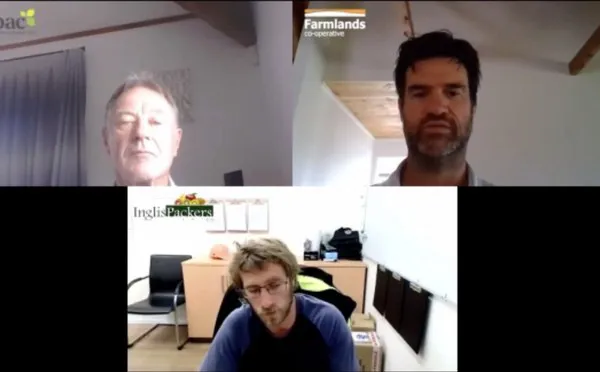“We’re living in challenging times.”
This is what David Tanner, managing director at Start Afresh Ltd., said at yesterday’s final Quality Summit of 2021 focusing on the kiwifruit category and hosted by Hazel Technologies Inc.
Tanner began the virtual summit outlining key challenges the kiwifruit industry currently faces. “There’s been rampant growth in the New Zealand kiwifruit industry in particular over the last 10 years--since Psa hit our industry,” he says. “The COVID-19 overlay isn’t helping business and operations. We have a lack of transient labor--backpackers commonly assist us and we’re not seeing a lot of backpackers. We’ve also got constraints in shipping.”
![]()
The need for technology
This sets the scene for a time when the kiwifruit industry continues to push forward with innovation and automation and look for labor-saving initiatives, including pre and post-harvest advancements. “There’s a real need for rapid implementation of new kiwifruit technologies,” Tanner adds.
With that in mind, Tanner touches on the relationship between modified atmosphere packaging (MAP) and 1-MCP technology, like Hazel produces. “By sealing the packaging system, there are all sorts of benefits gained--one is the retention of water vapor and the change in atmosphere helps change the respiration rate of the product. It’s been utilized in the New Zealand kiwifruit industry for one of its varieties,” says Tanner. “And shelf life assessments show that fruit that’s stored in MAP still ripen normally once it’s released from the bag.”
However MAP and kiwifruit aren’t without their challenges. “Kiwifruit are one of the more sensitive fruits to ethylene so you have to use ethylene scavenging technology to prevent build up in the pack,” Tanner says. Cold chain management and protecting the integrity of that cold chain is also paramount.
 Kiwifruit panel: Allan Clover (top left); Dwayne Farrington, technical leader – Kiwifruit and Subtropical Crops at Farmlands Co-operative Society Limited (top right); Josh Inglis, manager at Inglis Packers Limited (bottom).
Kiwifruit panel: Allan Clover (top left); Dwayne Farrington, technical leader – Kiwifruit and Subtropical Crops at Farmlands Co-operative Society Limited (top right); Josh Inglis, manager at Inglis Packers Limited (bottom).
Resolving challenges
However, he does also note that 1-MCP technology that inhibits ethylene and MAP have produced a unique challenge. “It’s how it impacts different tissues within the fruit which does vary by variety. Some of our varieties, when we treat them with 1 MCP, as the fruit ripens after treatment, the tissues ripen at different rates,” says Tanner. Notably, a harder core in the kiwifruit can be found which isn’t always preferred by consumers. “We’re still working through trying to resolve these challenges,” he says.
The session then moved to a panel discussion covering quality and pre-harvest innovation and the discussion turned towards the use of plant growth regulators that helps bud break on the fruit happen uniformly. (Hazel produces Hazel Trex which is pre-harvest technology that helps increase yields by optimizing the timing of dormancy breaking spray applications.)
Gut feeling
However, Allan Clover, grower services at Mount Pack & Cool notes that while scientific developments can lead the way in helping improve bud break and flowering results for, ultimately, better crops, “gut feelings” also have a role. “I still use it with science because when you use Hazel Trex, it gives you that time line or the potential day. But there’s no inclusion for weather conditions coming. So I use my gut feeling for that first test to see: are we picking about on time? Later?” Clover says. “Timing is important because we don’t want a wide flowering window. Gold3 can tend to do that so we want to condense that window to reduce the on-orchard costs for labor for thinning.”
Hazel Technologies’ director of business development – agtech, Mario Cervantes also noted that optimal application of technologies such as Hazel Trex will assist with labor challenges in the industry. “Hazel Trex measures the genetic indicators that the plant itself is expressing as it's approaching the end of dormancy. It helps optimize timing decisions to make best use of dormancy breakers in order to maximize the potential for increased bud break uniformity, king flower to lateral flower ratio and lower thinning costs,” Cervantes adds.
 For more information:
For more information:
Jaime Kedrowski
Hazel Technologies
Tel: +1 (559) 321-2146
jaime@hazeltechnologiesinc.com
www.hazeltechnologies.com
